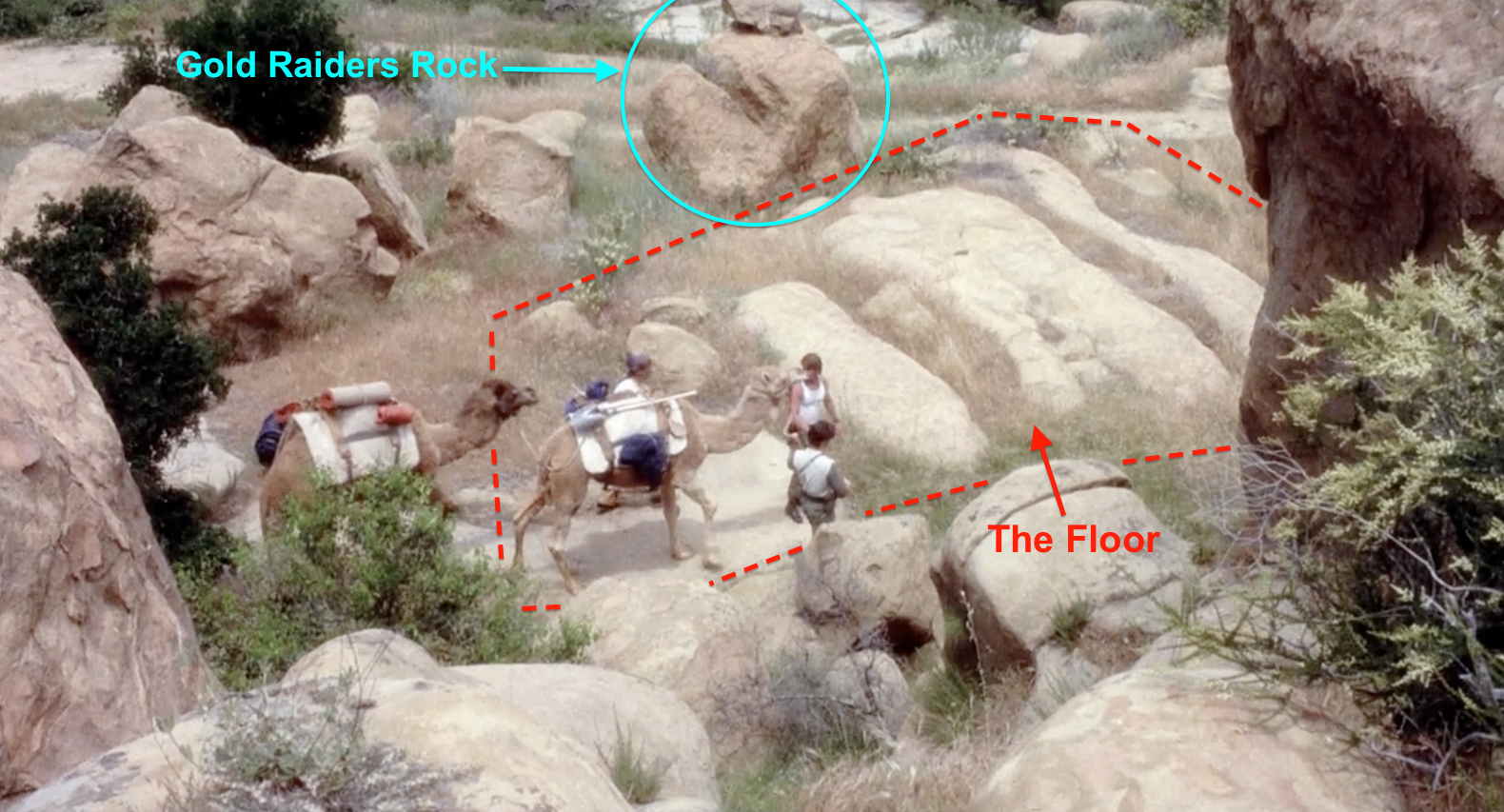Chuck Connors, left, and Dale Robertson in "Tales of Wells Fargo" (1957)
A couple of years before he became famous as "The Rifleman," Chuck Connors helped launch another TV Western, "Tales of Wells Fargo." Connors appeared alongside series star Dale Robertson in the first episode of the show, "The Thin Rope," which premiered March 18, 1957.
Connors and Robertson shared a stagecoach ride spanning most of the episode, filmed on the Upper Iverson Movie Ranch. The trip gave the two men plenty of time for male bonding … not to mention time to think about whether they might end up trying to kill each other. From a filming location standpoint, the episode was a showcase for the Upper Iverson.
Chuck Connors and Dale Robertson — note the road in the background
The producers tried to get away with a little movie hocus-pocus on that stagecoach trip, through the magic of rear projection and the ability to reverse footage horizontally, or "flip the shot." The above screen shot includes a landmark in the background, Road Up the Hill, and because we've seen the same road in countless other productions, we can see that it appears here horizontally flipped.
This version of the screen shot points out the flipped road in the background, along with the properly oriented actors. Today the Road Up the Hill is part of a firebreak and hiking trail known as Johnson Motorway.
My own "fixed" version of the shot, showing Road Up the Hill in its proper orientation
In the above doctored version of the screen shot, I've flipped the photo to show how the road should look. Unfortunately, this also reverses the actors — in effect creating mirror images of them.
"Go West, Young Lady" (1941)
Here's an example of Road Up the Hill in another production. The road was seen hundreds of times in the backgrounds of movies and TV shows shot on the Upper Iverson. Here the road appears in a scene from the Columbia Western comedy/musical "Go West, Young Lady," which starred Glenn Ford, Penny Singleton, Ann Miller and Charlie Ruggles.
In this version of the shot from "Go West, Young Lady" the Road Up the Hill is pointed out. It's seen more clearly here than in the reverse-projection footage used in "Tales of Wells Fargo," but its distinctive shape leaves no doubt that it's the same road.
"Tales of Wells Fargo" — Chuck and Dale approach the Reflecting Pool
Here we see the stagecoach negotiating an especially rocky stretch of road through Bobby's Bend. This rough piece of road, which I call the Floor, is ribbed with a series of large boulders, posing a formidable obstacle. While it seems nuts to even try to traverse this section of what could hardly be called a "road" in a rickety wooden stage, presumably this sort of thing was par for the course in the days of stagecoach travel — and here the stage does make it over the obstacle.
The photo contains a number of Upper Iverson features. You can learn more about these features by clicking on the following links: Wrench Rock, Smiling Lion, Two-Humper, the Aztec.
"The Tomb" (1986)
Here's one of the best views of the Floor that I've seen in any production. This view from high above Wrench Rock appears in the movie "The Tomb," a Fred Olen Ray film about an Egyptian curse with a cast that included John Carradine, Sybil Danning and Cameron Mitchell. It was one of the later films shot on this part of the Iverson Movie Ranch, and as you can see, the producers brought a couple of camels to the site for the shoot.
In this version of the photo from "The Tomb" I've identified the area I call the Floor, along with nearby Gold Raiders Rock, which is partially visible here. Please click here if you would like to see more photos from this unusual Upper Iverson shoot and learn more about "The Tomb" — including the Iverson location of the Tomb itself.
Back to that first "Tales of Wells Fargo" episode, this shot from the video clip above illustrates why the Reflecting Pool has that name, with the camera capturing a clear reflection of Wrench Rock in the pool.
The pool continues to be employed as a creative element as the sequence plays out. Here it conveys partial reflections of two of the bushwackers getting the drop on Chuck Connors. We also see Notch Rock directly above the head of one of the bad guys.
Chuck Connors in "Tales of Wells Fargo," with Wrench Rock in the background
The hat says "goofy Western sidekick" but the eyes say "bad intent." Connors plays an enigmatic character here — is he the naive rube Button Smith, or the notorious outlaw Pete Johnson? We get a tasty glimpse of both personas in his "Tales of Wells Fargo" appearance — and as anyone who ever saw "Nightmare in Badham County" can tell you, there was more to Chuck Connors than the upright citizen and loving dad he played on "The Rifleman."



.png)
-noted.png)
-noted.png)









4 comments:
Looks like Chuck is wearing John Wayne's famous hat for this episode. Did the Duke loan it to him as a good luck talisman? There must be a story behind this!
Chuck was posing as Button, but was really a bad guy out to steal the gold. Most stage drivers had hats like that. The brim blown flat by the constant wind.
Where is wrench rock located? In the private area of Upper Iverson or in the Mobile Home Park?
Wrench Rock is located on the former Upper Iverson, which unfortunately is a gated community today and is all private property. If you're familiar with Cactus Hill, the hill that separated the Upper and Lower Iverson and today sits immediately north of the 118 Freeway west of Topanga Canyon Boulevard, Wrench Rock is positioned along the base of Cactus Hill, on the north side of the hill.
Post a Comment